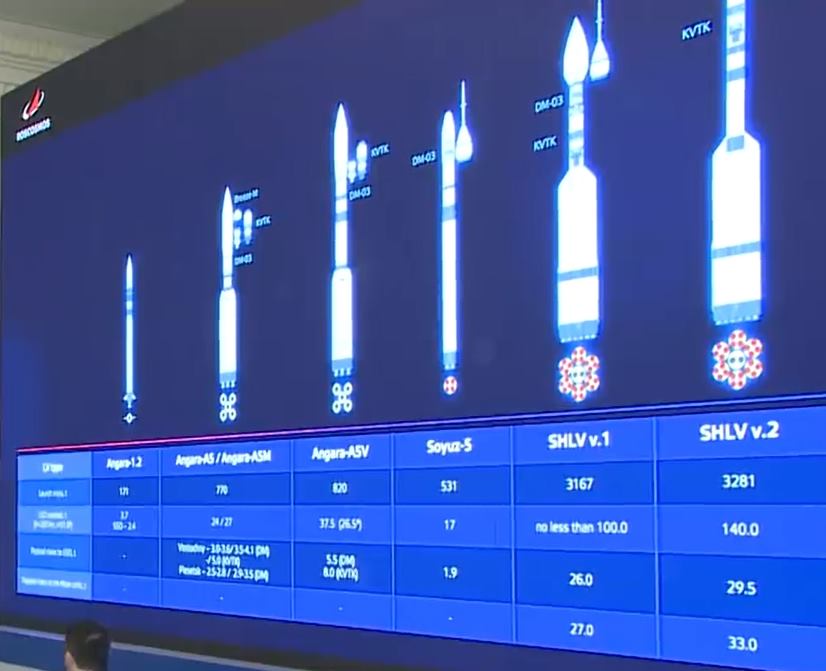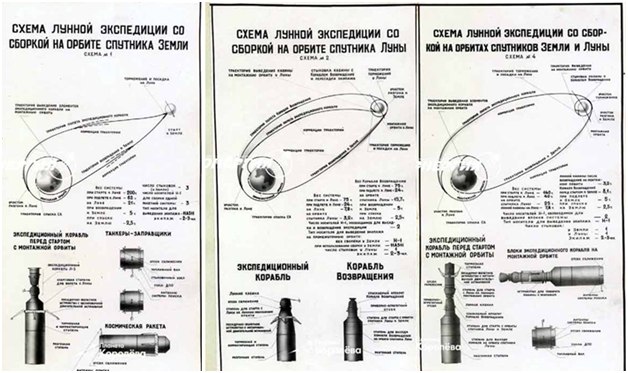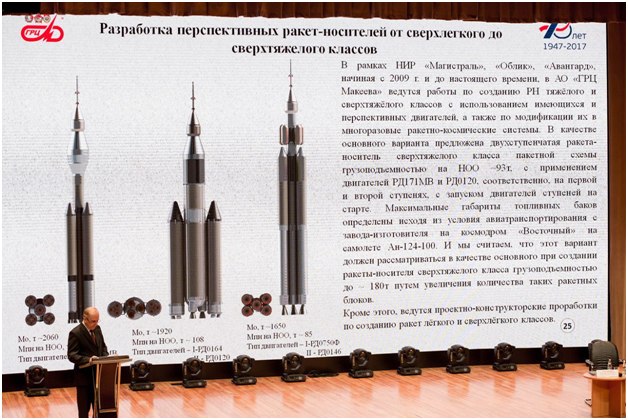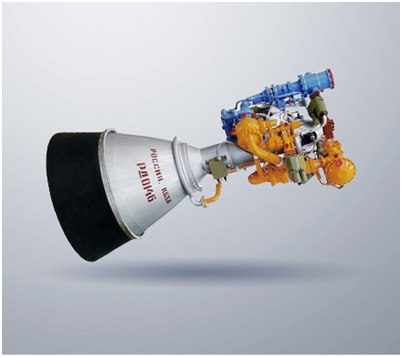On the way of Sergei Pavlovich Korolev. Modern Russian manned project. Part 2. Rocket

Continued. First part here
In this part, we consider our mission to the moon. To simplify the task, I decided to disassemble only manned missions.
To better understand the current version, let's look at a bunch of blocks intended to be sent to the Moon, but in orbit of the Earth.

')
Presented here are the manned ship “Federation”, the “D” block to enter the Moon’s orbit and the upper stage (roughly KVTK-2), which is necessary for sending the complex to the Moon.
If we replace the Federation in this bundle with a lunar landing gear, then it can be successfully delivered to the lunar orbit. Well, after docking in the lunar orbit of it with the "Federation", we get a full-fledged complex for disembarking astronauts.
Moreover, in this case we are following the path of Sergei Pavlovich Korolev. While he was forced to switch to a single-launch flight to the Moon, he had long considered options with several docks. Then everything was conveniently assembled under the H1 rocket with a carrying capacity of 75 tons. When they decided to switch to one launch, it was necessary to urgently force a missile to 92 tons, and still the complex was very difficult to start: until the very end he had problems with the mass.
The current Russian version is partly close to the “Scheme 2” of Korolev's proposals.

Korolev was convinced that the future of the orbit of the Earth or the Moon was in progress, that the cosmonautics should develop in this direction and that elements would soon be assembled in orbit, either by joining from separate modules or by manual assembling of large-sized structures by astronauts. If you look at the ISS, then Korolev was absolutely right.
It was he who then put a lot of effort into developing automatic docking systems, overcoming powerful resistance in its creation, thanks to which we had a similar system in 1967. This is the fact that it was no longer needed for the single-launch moon mission! For example, in the USA it appeared only in the present, 2019.
Here is what Korolev himself said on a similar occasion in 1965:
record from the pre-flight conference "Voskhod-2".
Let's go back to our time. We determined that for a flight to the Moon it is necessary to have a complex of about 90 tons in orbit. How to get him there? You can, for example, assemble in orbit. If we had a carrier with a carrying capacity of 50 tons, then it would be possible to put a ship with a “D” block with one launch into orbit, a booster block with another and dock them in orbit, having received the necessary complex.
It is seen that in this embodiment, the maximum carrying capacity of the carrier is determined by the maximum mass of the monoblock. In this case, the upper stage. If the mass is less, then in theory you can go to the refueling on the Earth's orbit, but the overall complexity of the mission is already increasing disproportionately, and reliability decreases.
A smaller carrier has a lower price, and greater demand in other programs. Because of this, for a long time, we considered exactly the scheme with docking in the Earth’s orbit. The advantages of such a scheme were broken about a simple fact: where can we get a carrier with a carrying capacity of 45-50 tons?
Angara
I am sure that now many have remembered about our carrier “Angara”, which just promised a rather large range of loads due to the modularity of the design.
And it was her that used to be sometimes drawn in this assignment. Example:

Just to the left is the “Federation” with the “D” block, and then the hydrogen accelerating block for the ligament to the Moon. Obviously, the option for docking in Earth orbit. Alas, it was only an estimate. It soon became clear that the Angara-A5, even with a special stage, is not suitable for this.
Unfortunately, this rocket began to be developed at a very difficult time, when many decisions were made on the basis of certain restrictions, which are now of little relevance, and it turned out to be very far from ideal.
The main idea of the modular approach when designing the Angara launch vehicle family was to try to make several universal modules from which to collect carriers of different payloads.
Relatively speaking, if a single-module rocket can put one ton into orbit, then by linking three rockets, we get three tons, five rockets - five tons. The assessment is conditional, since it is best to have the last step for each carrier to have its own, but as a first approximation the line of carriers shows.
The idea is not new and not even unique. Long before the first launch of the Angara, Delta-4, built using this approach, flew into space, and now the heavy Falcon has been added to such carriers.
The problem is what specific dimension to choose for a single-module carrier? Alas, this issue in the development of "Angara" was decided not in the best way. The developers wanted to close the dimension of the rocket all existing niches in the market, but to use as much of the finished equipment as possible. Much later changed, but the parameters that were laid back in the 90s remained.
The result was the following: Angara-A1, Angara-A3, Angara-A5, Angara-A7

How good it would be if the light Angara-1.2 were the most demanded, and the heavy Angar-A5 could be assembled on demand from waste elements! Alas, just the "Angara-A5" is now much more necessary: only it can completely replace the "Proton" in such an important direction as the launches at the GSO. At the same time, it is also the most difficult, and for the time being, much more expensive to manufacture than Proton.
I remember well the sad commentary on the first “A5” export (on the left of the Zenit PH for comparison).

“Eh. They took one RD-171 from the Zenith, sawed into four parts, put them on their block and assembled a rocket from them. ”Of course, according to the performance characteristics of the "Angara" much better than the "Zenith". In particular, the Zenith service station corresponds to the “A3” with three engines, but still the rocket is unnecessarily complex in terms of the number of blocks, the cyclogram, and much more. It means that it is less reliable.
What is worse, "A5" is almost the maximum possible carrier with this layout. It would seem that the maximum stalby "A7". If you recall the geometry, it is easy to understand that a maximum of six blocks of the same diameter can be hung on one block. But technically it is already difficult to do. The central unit is too small compared to the first stage. If you look at the diagram above, you will see that the central block has already been drawn with a larger diameter. This means that there is no unification, and it is necessary to develop a central unit from scratch. Because of what the project "A7" was closed, the replacement was proposed for the Angara-A5B launch vehicle with the hydrogen last stage, but it does not reach the load required for lunar manned missions.
"Soyuz-5" and super-heavy carrier
Actually, the idea lies on the surface. What if you develop a universal carrier, but with a block of a different size? It is perfectly ideal if the minimum possible unit would have the dimension of the “Proton” - as the most demanded. Then, when assembling modules, for example, in three elements, we already get 66-69 tons in Earth orbit. For the assembly in Earth orbit this is enough. And if you put together five modules, then you don’t need to suffer with the assembly: everything is displayed in one launch, with a margin. That’s what SpaceX did when developing “FalconHavi” - they took the most popular carrier and got extra heavyweight.
It was clear to us, as well as the problems of the "Angara", because of which she had been in limbo for so long. At the same time, we had a lot of various research projects devoted to choosing a new carrier within the framework of the initial restrictions, in the process of which a lot of various options were considered. Here are some options from the Makeev Center.

Here from the center to them. Khrunichev.


After that, for a more detailed study, an offer was selected from RSC Energia, where the single-unit rocket received the Soyuz-5 index, and the rest were assembled on its base with a high level of unifications. A bundle of six blocks at the first stage (five side and central) provided the carrier with a carrying capacity of about 88 tons, while using hydrogen at the top stage, the payload increased to 108 tons. These options were to directly display the "Federation" and the landing ship to the Moon, followed by docking in orbit.

This option was considered as early as 2018, when it was decided to increase both the starting mass and the load capacity of the base version.

The Soyuz-5 launch vehicle remained the same as the base, but an increase in the number of side blocks from five to six forced the central unit to change. The engine on it was changed from RD-171 to RD-180. Roughly speaking, they changed the traction by half, which reduced the unification between the side and central blocks, but this need was due to the scheme itself. After this version, the basic load capacity increased to 100 tons, and with the hydrogen upper stage - to 140 tons. This option, voiced at the end of April 2019, and was adopted as the base. This is a really important point, because the options for five and six blocks are very different geometrically, and before starting the design of the launch complex, you need to know exactly which one will be chosen.
In our realities there is one nuance that should be mentioned. The fact is that the stage with the dimensions of the first stage of the Zenith is practically the maximum possible size that we can deliver to the cosmodrome.
Over the past years, many proposals have been made on the delivery of elements of rocket and space technology to space centers. They offered to float on water, deliver by wheel transport, create an air delivery system. But the plans remained on paper, heavy planes were owned by another state, and the only reliable way was delivery by rail. There are restrictions on the dimensions of the cargo: 3900 mm without stopping oncoming traffic and 4100 with a stop. "Proton" was inscribed in 4100 mm, Zenith in 3900. Strongly not clear. Perhaps the project "Soyuz-5" and won due to the fact that all the blocks decided to pack in the railway envelope. If you look at other projects, you will see steps with large diameters. Four meters for heavy carriers is really small. I would like at least five.
It was clear for a long time. On the basis of these criteria, the Zenit PH was also assembled - in particular, they developed a very efficient RD-171 engine, which was originally planned for a new carrier. Alas, his thrust began to limit the maximum mass of one-piece carrier.
As a result of these restrictions, the Soyuz-5 Monks were able to increase from 12 tons that Zenit had to 17. Although it is not so scary. This carrier got exactly in the interval between Soyuz-2 (10 tons) and Angara-A5 (25 tons). Without it, we got too big a step between the carriers available to the Russian Federation. Those loads that were realized with a certain underload by the “Proton” can go to it. Moreover, if we manage to keep the Sea Launch, then the Soyuz-5 from it due to the best geography of the launch point at the GPO / GSO will pass even the Angar-A5 from East from the payload.
By the way, if what I’m sure of is, it’s in the fact that Soyuz-5 will be brought exactly and, possibly, even launched in the agreed 2022. To create it already has a lot. It is planned to launch it from Baikonur, from the Zenit launch complex, so that at least for the first launches it does not need to change significantly. Let's not forget that the launch complex is up to 60% of the work on the space-rocket system. The launch complex on Vostochny for the Soyuz-5 is planned to be created later, as part of the construction of the super heavy launch vehicle.
The engine of the first stage is also available, and this is usually the most difficult part. Diameter of waste. If there are problems with anything, it is with the second stage engine. Among the serial we, alas, do not have suitable for the burden. Do not put the same ancient RD-108 of the beginning of the space age? The rest are either too weak or too powerful. For example, how good it would be to put on the top step of the RD-191 (development based on the RD-171). Perfect unification would turn out! But he has 200 tons, and you need about 100.
While they are planning to deliver a highly modified engine from the third stage of the Soyuz-2 to the upper stage, its high specific impulse is clearly captivating. But it is so well optimized for Soyuz, that it doesn’t scale well for heavier media. Recently it was announced about the restoration of "Energomash" production of RD-120. This engine was at the second stage of “Zenith” and was previously produced in Ukraine. It may well be that they restore it with an eye to the "Soyuz-5". At least as an option, if Voronezh fails.
As can be seen in the diagram, on the base of the Soyuz-5 it is already possible to assemble super-weights of 88 and 108 tons. The first one is for launching a “Federation” to the Moon with a braking unit, the second one is for sending a lunar landing ship to the Moon’s orbit.
What else do we have for this, and what needs to be created? It should be noted that for the 88-ton carrier, the required engines are already available or will appear in the process of developing the Soyuz-5.
First of all, it is the engine of the RD-0146D accelerating unit.

The base RD-0146 did not fly, but passed all the tests. From the base version, the RD-0146D should differ by an increased specific impulse and multiple switching on. If implemented, this engine will be the record for specific impulse (470 s) among oxygen-hydrogen analogues.
The only engine that needs to be developed from scratch here is the 140-ton super-heavy engine. Product design under the symbol RD-0150 began about five years ago.
Much more has been done for the Federation, right up to the development of individual components. You can arrange the whole exhibition, which show that is already ready. Like exhibitions organized by NASA in the 60s under the Apollo program. Either stationary or mobile, on the train - this has recently become fashionable. In my opinion, such an exhibition would be very useful in promoting this area, as the information support is now practically absent. It would be really great if Roscosmos did something similar.
Current start schedule
Now I will try to describe what our Moon program looks like now. A kind of cut at the moment. I think it will be interesting to look at all these wonderful plans in ten years.
Approximately 2021-2024
The development of the Soyuz-5 launcher ends and its first launches from the Baikonur cosmodrome take place. Last year, the “Federation” mockup was listed as a PN of the first launches (which was not a problem), but this year, it seems, they have tightened the nuts and already say that the launches will take place already with the Federation ship, even if in the test version . One of the flights of the "Federation" promise to hold to the ISS.
At the same time, the construction of the Angara-A5 and A5B ICs in the East ends. And it was planned to use it for the moon, but in a peculiar way. The fact is that our method of delivering to the orbit of the moon with the help of an overclocking unit is good because RB doesn’t really matter what to put into this orbit. As a result, with the presence of “5”, with relatively small efforts we will be able to deliver “Progress” to the orbit of the Moon, close to those that fly to the ISS.
Progress-L launches were carried out as part of our proposals for the international lunar station Getway. For our plans, they are not very necessary. After the recent announcement by Trump, plans in the American lunar program have also changed dramatically. In which variant will the lunar station be and whether it will be at all, now is a big question. Moreover, will Russia become involved in the same project with America, in the light of recent statements from the Pentagon to ban cooperation during joint launches, the question is even bigger.
Also during this period our automatic mission “Luna-25” should fly, and if you are lucky, then “Luna-26”. Hope successful.
The fact that in these years everything will be relatively close to my forecast, I am sure. I do not see the pitfalls. Much "iron" is in a high degree of readiness. In particular, the manufacture of tanks of the first "Union-5" has already begun
The question is in the success of these missions. It depends on this, what will happen next.
2024-2027
The main work that should be carried out in these years is the construction of the launch complex of a super-heavy rocket at the Vostochny cosmodrome. At the same time, the statistics of Federation and Soyuz-5 should be worked out, and if we are seriously aiming at the Moon, the development of the landing module should begin. Perhaps this is the only element for which there is no noticeable movement.
Even for this period, there was a launch on the Angar of our gateway module to Getway and, perhaps, Progress-L, but, as I wrote above, now it seems that even in the USA they don’t know in which version the station will be.
Well, again, several landings of lunar automatic vehicles are possible, if the previous ones are successful.
2028-2032
Ten years later, we just have to finish building a new launch complex and start flying to the moon. Personally, I would love to see it. I hope that the plans, although they will be transferred (they are always transferred), but still they will be successfully implemented.
In ten years we will know for sure.
Source: https://habr.com/ru/post/457308/
All Articles